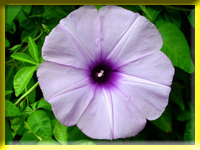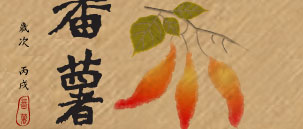





|
Distant relative and close neighbors
|
| |
While arranging the tapes of interviewing Dr. Yong-Chang Lai, we realized the close relatives of sweet potato are the water convolvulus, morning glory, saddle rattan, etc. that belong to the same category of Ipomoea. The scientific term of sweet potato is (the Ipomoea batatas); that of morning glory is (the Ipomoea imperialis), and that of the saddle rattan is (the Ipomoea pes-caprae). As they all belong to the same the flower section of Convolvulaceae, they indeed are the relatives of sweet potato!
|
|
| |
|
|
|
| |
| |
Ipomoea pes-caprae (L.) Sweet.
|
|
| |

Ipomoea pes-caprae (L.) Sweet. |
Popular name |
Rattan, thick rattan |
Name of section |
Convolvulaceae |
Characteristic |
The saddle rattan belongs to the convolute flower section. It is a perennial herb, distributing in the tropical zone and subtropics coast worldwide. Its caulis is long and crawls to the ground. Its leaves are arrayed with each other, the length is 4~8 cm, the breadth is 4~10 cm. It has long leafstalk that is around 12 cm in length. The whole plant are smooth, the front side is concave such as sadden. The flower of the saddle rattan is big, particularly obvious and gorgeous. It is called "the Queen of Flower on the Beach". Its flower is purple red; its corolla is in funnel form with a diameter up to 8.cm. The fruit is round with dry and membraniferous qualities. There are four seeds inside. Ecological habit: Wind-resistant salt- and drought-tolerable. Each section can grow into a root, and the root goes deep into the sandy ground. It is a very good plant for defending wind and firming sand. It is often seen that a lot of saddle rattans crawl to spread all over the sandy beach along the seashore. They are blooming prolifically in the morning and we can enjoy a sight of a sea of flowers; however they quickly wither in the afternoon. People of Da-Wu tribe usually pull out the cane, cirri, and leaves of the saddle rattan to make use of them in clear the ashes that resulted from burning pottery or tying arundos with its caulis to serve as torches. |
|
|
|
| |
| |
|
| |
| |
| |
|
|
| |

Morning glory |
Name of section |
Convolvuluses |
Origin |
Tropical Asia, African etc. |
Characteristic |
Morning glory belongs to the convoluted flower section. It is annual curl herb, The whole plant is covered with the thick, hard or soft hair. Her cane claspes or grows bendingly as the so-called clasped cane. The blossom looks like a horn , and that's why it got the name of morning glory. There are five stamens and five calyxes; shape of leaves are wide and oval, often split by three parts. The corolla is in funnel form. The stamen and the flower column hide in the corolla tube. There are 3 rooms in ovary. The seed looks like an egg. There are 3~6 seeds inside. The seed surface is in grey white color. In addition to the ordinary tendril species that most people are more familiar with, morning glory has another species which is with early anthesis. Morning glory can use the method of sowing seeds and inseting them to breed. When the flower starts climbing, remember to take off the core so that it is easy to divaricate it. Due to the fact that the leaves of morning glory is big, the humidity evaporates quickerly and hence the humidity needs to be sufficient. It is required to manure it regularlyduring the period of blossom.
¡@¡@
|
|
|
|
| |
| |
|
| |
| |
| |
|
|
| |
|
|
| Name of section |
Convolvulaceae |
| Nickname |
Jar vegetables |
| Distribution |
All over Taiwan. Grows in the paddy field, ditch, riverside and marsh. |
Characteristic of appearance |
Perennial herb, Creeper with a hollow stem, and that's why it is named "hollow vegetable¡¨ in Chinese. Its leaves are arrayed with each other, resembling an egg and are in needle form. Their length is 5 - 10.5 cm, width 2.5 - 4 cm. The leaves are with long leafstalk. These characteristics make it existent in the environment of water. The corolla is in funnel form. Its color is from white to light purple. The appearance is like morning glory very much. The ways to plant it are cultivation in dry land and in the water. The main species of dry land cultivation is bamboo leaf; the main species of water cultivation is big leaf. It has few plant diseases and insect pest; its yields are plenty and with rich nutrition. The usual water convolvulus that we eat is cultivated; in fact, it is a kind of pure hydrophyte. The famous hydroponics hot-springs water convolvulus in Jiao-Xi, Yilan, is also cultivated by its growth characteristics. The water convolvulus only can be tasted in summer several years ago, but is available to be enjoyed all year round nowadays due to the breeding efforts and farmers' hard work.
¡@¡@
|
|
|
|
| |
|
|
|
|




